Secreted phospholipase A2 group X overexpression in asthma and bronchial hyperresponsiveness
- PMID: 17901411
- PMCID: PMC2176098
- DOI: 10.1164/rccm.200707-1088OC
Secreted phospholipase A2 group X overexpression in asthma and bronchial hyperresponsiveness
Abstract
Rationale: Secreted phospholipase A(2) enzymes (sPLA(2)s) play key regulatory roles in the biosynthesis of eicosanoids, such as the cysteinyl leukotrienes, but the role of these enzymes in the pathogenesis of asthma is not known.
Objectives: To establish if sPLA(2)s are overexpressed in the airways of patients with asthma, and to determine if these enzymes may play a role in the generation of eicosanoids in exercise-induced bronchoconstriction.
Methods: Induced sputum samples were obtained from subjects with asthma with exercise-induced bronchoconstriction and nonasthmatic control subjects at baseline, and on a separate day 30 minutes after exercise challenge. The expression of the PLA(2)s in induced sputum cells and supernatant was determined by quantitative polymerase chain reaction, immunocytochemistry, and Western blot.
Measurements and main results: The sPLA(2)s expressed at the highest levels in airway cells of subjects with asthma were groups X and XIIA. Group X sPLA(2) (sPLA(2)-X) was differentially overexpressed in asthma and localized to airway epithelial cells and bronchial macrophages. The gene expression, immunostaining in airway epithelial cells and bronchial macrophages, and the level of the extracellular sPLA(2)-X protein in the airways increased in response to exercise challenge in the asthma group, whereas the levels were lower and unchanged after challenge in nonasthmatic control subjects.
Conclusions: Increased expression of sPLA(2)-X may play a key role in the dysregulated eicosanoid synthesis in asthma.
Figures
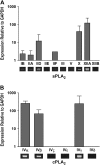

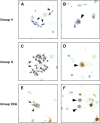
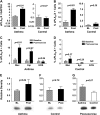
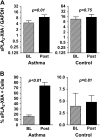
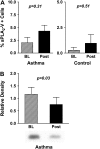
Similar articles
-
Epithelial regulation of eicosanoid production in asthma.Pulm Pharmacol Ther. 2012 Dec;25(6):432-7. doi: 10.1016/j.pupt.2012.02.004. Pulm Pharmacol Ther. 2012. PMID: 23323271 Free PMC article. Review.
-
Exercise-induced alterations in phospholipid hydrolysis, airway surfactant, and eicosanoids and their role in airway hyperresponsiveness in asthma.Am J Physiol Lung Cell Mol Physiol. 2021 May 1;320(5):L705-L714. doi: 10.1152/ajplung.00546.2020. Epub 2021 Feb 3. Am J Physiol Lung Cell Mol Physiol. 2021. PMID: 33533300 Free PMC article.
-
Transglutaminase 2, a novel regulator of eicosanoid production in asthma revealed by genome-wide expression profiling of distinct asthma phenotypes.PLoS One. 2010 Jan 5;5(1):e8583. doi: 10.1371/journal.pone.0008583. PLoS One. 2010. PMID: 20052409 Free PMC article.
-
Relationship between levels of secreted phospholipase A₂ groups IIA and X in the airways and asthma severity.Clin Exp Allergy. 2011 Jun;41(6):801-10. doi: 10.1111/j.1365-2222.2010.03676.x. Epub 2011 Jan 24. Clin Exp Allergy. 2011. PMID: 21255140 Free PMC article.
-
New insights into pathogenesis of exercise-induced bronchoconstriction.Curr Opin Allergy Clin Immunol. 2012 Feb;12(1):42-8. doi: 10.1097/ACI.0b013e32834ecc67. Curr Opin Allergy Clin Immunol. 2012. PMID: 22157157 Free PMC article. Review.
Cited by
-
CD1a and skin T cells: a pathway for therapeutic intervention.Clin Exp Dermatol. 2024 Apr 23;49(5):450-458. doi: 10.1093/ced/llad460. Clin Exp Dermatol. 2024. PMID: 38173286 Free PMC article. Review.
-
Induced sputum proteome in healthy subjects and asthmatic patients.J Allergy Clin Immunol. 2011 Dec;128(6):1176-1184.e6. doi: 10.1016/j.jaci.2011.07.053. Epub 2011 Sep 8. J Allergy Clin Immunol. 2011. PMID: 21906793 Free PMC article.
-
Alternatively activated macrophages; a double-edged sword in allergic asthma.J Transl Med. 2020 Feb 5;18(1):58. doi: 10.1186/s12967-020-02251-w. J Transl Med. 2020. PMID: 32024540 Free PMC article. Review.
-
Group X secretory phospholipase A2 enhances TLR4 signaling in macrophages.J Immunol. 2011 Jul 1;187(1):482-9. doi: 10.4049/jimmunol.1003552. Epub 2011 May 27. J Immunol. 2011. PMID: 21622863 Free PMC article.
-
Endomorphin-2- and Neurotensin- Based Chimeric Peptide Attenuates Airway Inflammation in Mouse Model of Nonallergic Asthma.Int J Mol Sci. 2019 Nov 26;20(23):5935. doi: 10.3390/ijms20235935. Int J Mol Sci. 2019. PMID: 31779093 Free PMC article.
References
-
- Hallstrand TS, Henderson WR Jr. Leukotriene modifiers. Med Clin North Am 2002;86:1009–1033. - PubMed
-
- Pavord ID, Ward R, Woltmann G, Wardlaw AJ, Sheller JR, Dworski R. Induced sputum eicosanoid concentrations in asthma. Am J Respir Crit Care Med 1999;160:1905–1909. - PubMed
-
- Griffin M, Weiss JW, Leitch AG, McFadden ER Jr, Corey EJ, Austen KF, Drazen JM. Effects of leukotriene D on the airways in asthma. N Engl J Med 1983;308:436–439. - PubMed
-
- Hardy CC, Robinson C, Tattersfield AE, Holgate ST. The bronchoconstrictor effect of inhaled prostaglandin D2 in normal and asthmatic men. N Engl J Med 1984;311:209–213. - PubMed
-
- Mathe AA, Hedqvist P. Effect of prostaglandins F2 alpha and E2 on airway conductance in healthy subjects and asthmatic patients. Am Rev Respir Dis 1975;111:313–320. - PubMed

